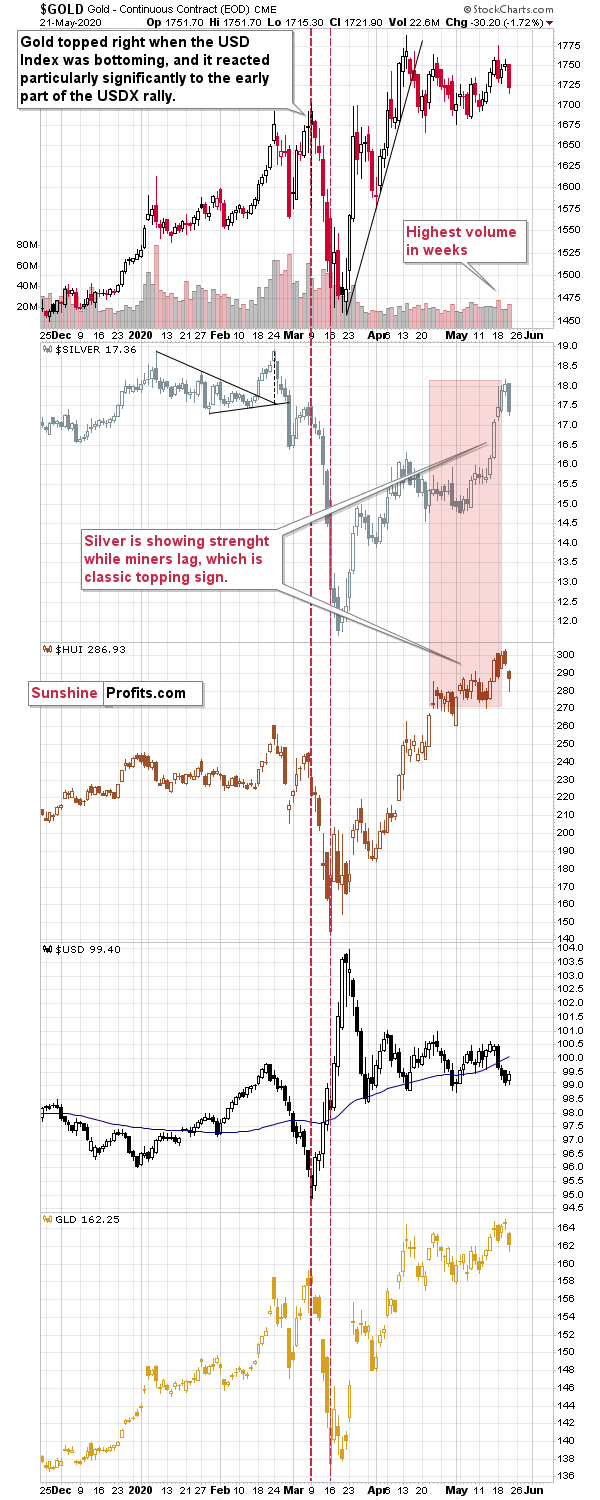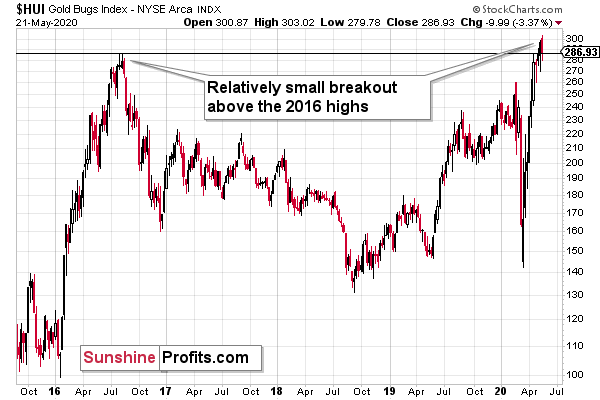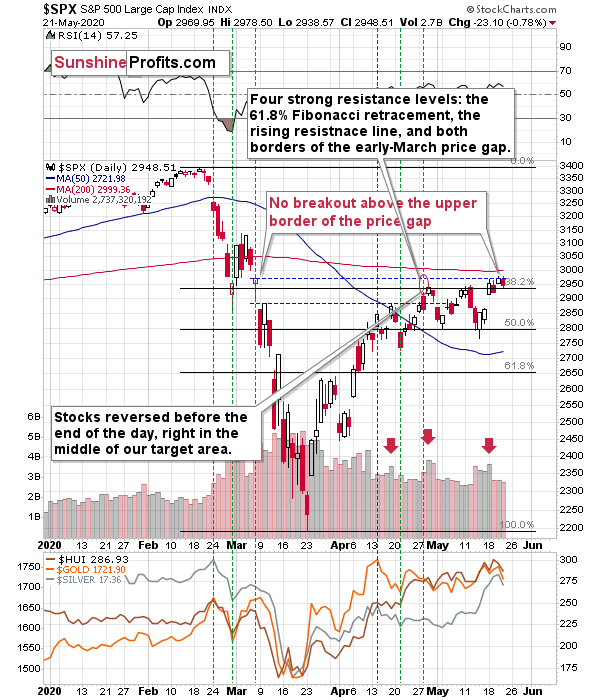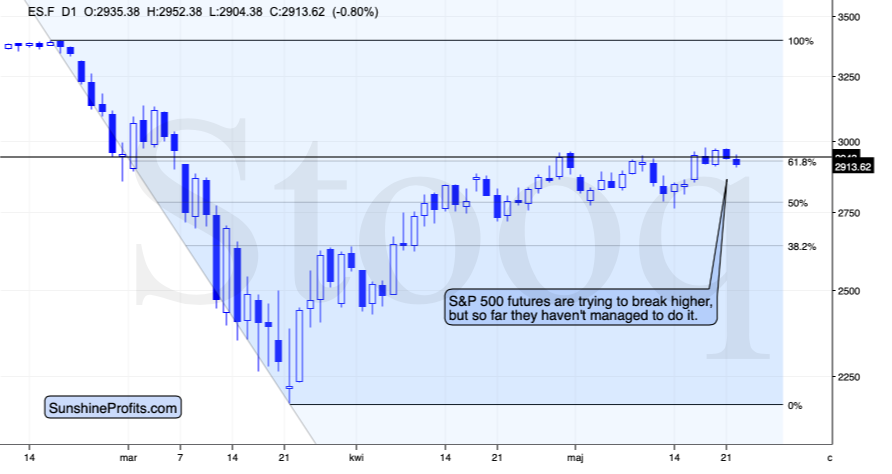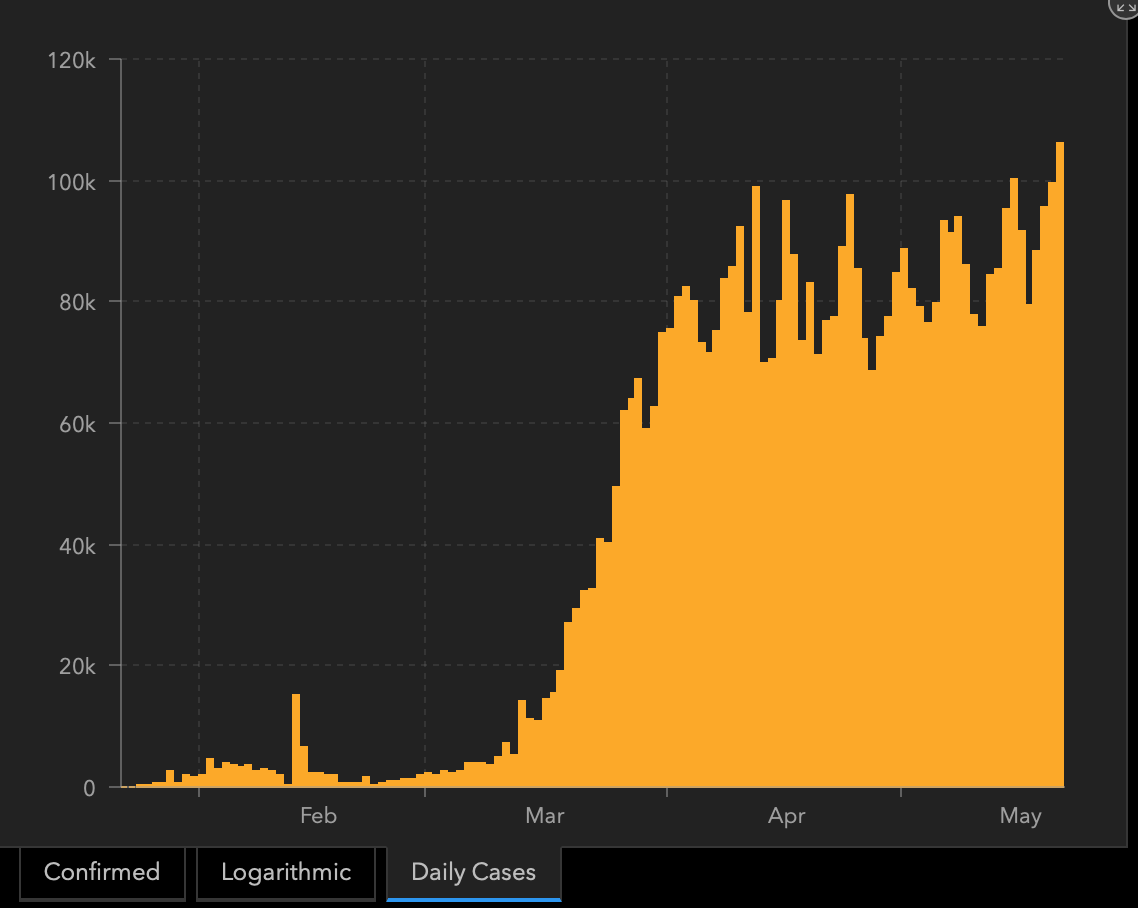Briefly: in our opinion, full (150% of the regular position size) speculative short positions in mining stocks are justified from the risk/reward point of view at the moment of publishing this Alert.
The precious metals market finally turned down yesterday, at least if you focus on silver as the leading indicator of where things are heading. In yesterday's analysis, we wrote that the white metal's tops are usually the most clear ones due to their shape as it's quite often a big, clear spike. It seems we have just seen one.
Yesterday, we wrote the following with regard to silver:
The previous reversal was quickly followed by even higher silver prices, so it's too early to open the champagne and claim that the top is definitely in, but given silver's recent clear outperformance of gold and the verification of the breakout above the 100 in the gold to silver ratio, the above seems quite likely.
Once silver futures break below the $17.17 level (the most recent low), it will be almost crystal-clear that the top is in. The next very short-term target area for silver is between $16.30 and $15.80. Then, after a brief pause, we would expect the decline to continue.
The above is up-to-date. Silver moved lower yesterday, and it moved temporarily lower also today, but it didn't move below the most recent low of $17.17. Consequently, while it's quite likely that silver already topped, it's too early to say that with 100% confidence.
We also wrote the following with regard to gold miners:
The HUI Index invalidated the breakout above the 300 level, but it didn't invalidate the breakout above the 2016 high (286.05) just yet. Once it does that, the bearish picture will become even more bearish.
Ideally, we would like to see the HUI Index close below the highest weekly close of 2016 - 278.61.
As you can see on the above chart, the HUI Index declined, but it didn't close below any of the above-mentioned support levels. Consequently, what we're seeing now, could be viewed as breakout's verification, not invalidation, which would be bullish. Of course, it's too early to say that miners have indeed verified the breakout, as they haven't really rallied after moving back to the 2016 highs. It more likely the case that they weren't able to invalidate the breakout during just one day.
The precious metals market didn't get many bearish leads - neither from the USD Index, nor from the general stock market, so the fact that miners declined over 3% is quite notable.
The USDX moved higher by just 0.27, and the S&P 500 Index moved lower by just 0.78%.
The USDX confirmed the breakdown below the 50-day moving average, but it didn't move below the most recent lows. What should one make of it? One should look at PMs' reaction to both developments. PMs and miners didn't really react to the confirmation of the breakdown, but they reacted to the tiny show of USD's strength close to the previous lows. Consequently, it seems that the support provided by the latter is more important (from the PM investors' and traders' point of view) than the moving average. The implications of the current situation in the USDX and the PM-USD link are bearish for the PMs.
As far as the stock market is concerned, we saw something particularly interesting in both: S&P 500 and in the S&P 500 futures.
The index moved and closed for two consecutive trading days above the 61.8% Fibonacci retracement, but it never closed the early-March price gap. The upper border of the latter provided resistance and stocks moved lower.
The S&P 500 futures did manage to close the early-March gap, but they then declined and are currently (at the moment of writing these words) back below both: April high and the 61.8% Fibonacci retracement level.
Both previous attempts to move above the 61.8% Fibonacci retracement that failed were followed by a quick move below the 50% retracement. The history rhymes, so we might be looking at another quick move lower. This time, however, stocks might not end their decline there, but move even lower instead. The ratio between optimism regarding the Great Unlock and how much the economy is improving (barely) might have reached its peak.
Plus, in global terms, the pandemic is far from being over. In fact, just today we saw the highest daily increase in new Covid-19 cases.
The growth in cases comes mostly from the BRIC countries and emerging economies in general. As we outlined previously, this is likely to put buying pressure on the US dollar, which is viewed as the safe-haven currency.
We are going to discuss the economic implications of the above in great detail in the upcoming Gold Market Overview, but we can already say that a V-shaped economic recovery is very unlikely.
If the stock market slides again, miners are likely to slide relative to gold once again, in particular the junior mining stocks.
Summary
Summing up, despite the very recent moves higher, especially in silver, the outlook for the precious metals market is bearish for the next few weeks, and it's very bullish for the following months. Even if gold, silver, and mining stocks are not going to move to new 2020 lows, they are still likely to decline visibly when the USD Index soars. Based on Monday's reversals in gold and silver, as well as silver's previous outperformance and the verification of the breakout in the gold to silver ratio by the move back to the 100 level, it seems that the end of the current short-term upswing is at hand.
After the sell-off (that takes gold below $1,400), we expect the precious metals to rally significantly. The final decline might take as little as 1-3 weeks, so it's important to stay alert to any changes.
Most importantly - stay healthy and safe. We made a lot of money on the March decline and the subsequent rebound (its initial part) price moves (and we'll likely make much more in the following weeks and months), but you have to be healthy to really enjoy the results.
As always, we'll keep you - our subscribers - informed.
To summarize:
Trading capital (supplementary part of the portfolio; our opinion): Full speculative short positions (150% of the full position) in mining stocks is justified from the risk to reward point of view with the following binding exit profit-take price levels:
Senior mining stocks (price levels for the GDX ETF): binding profit-take exit price: $10.32; stop-loss: none (the volatility is too big to justify a SL order in case of this particular trade); binding profit-take level for the DUST ETF: $231.75; stop-loss for the DUST ETF: none (the volatility is too big to justify a SL order in case of this particular trade)
Junior mining stocks (price levels for the GDXJ ETF): binding profit-take exit price: $9.57; stop-loss: none (the volatility is too big to justify a SL order in case of this particular trade); binding profit-take level for the JDST ETF: $284.25; stop-loss for the JDST ETF: none (the volatility is too big to justify a SL order in case of this particular trade)
For-your-information targets (our opinion; we continue to think that mining stocks are the preferred way of taking advantage of the upcoming price move, but if for whatever reason one wants / has to use silver or gold for this trade, we are providing the details anyway. In our view, silver has greater potential than gold does):
Silver futures downside profit-take exit price: $8.58 (the downside potential for silver is significant, but likely not as big as the one in the mining stocks)
Gold futures downside profit-take exit price: $1,382 (the target for gold is least clear; it might drop to even $1,170 or so; the downside potential for gold is significant, but likely not as big as the one in the mining stocks or silver)
Long-term capital (core part of the portfolio; our opinion): No positions (in other words: cash)
Insurance capital (core part of the portfolio; our opinion): Full position
Whether you already subscribed or not, we encourage you to find out how to make the most of our alerts and read our replies to the most common alert-and-gold-trading-related-questions.
Please note that the in the trading section we describe the situation for the day that the alert is posted. In other words, it we are writing about a speculative position, it means that it is up-to-date on the day it was posted. We are also featuring the initial target prices, so that you can decide whether keeping a position on a given day is something that is in tune with your approach (some moves are too small for medium-term traders and some might appear too big for day-traders).
Plus, you might want to read why our stop-loss orders are usually relatively far from the current price.
Please note that a full position doesn't mean using all of the capital for a given trade. You will find details on our thoughts on gold portfolio structuring in the Key Insights section on our website.
As a reminder - "initial target price" means exactly that - an "initial" one, it's not a price level at which we suggest closing positions. If this becomes the case (like it did in the previous trade) we will refer to these levels as levels of exit orders (exactly as we've done previously). Stop-loss levels, however, are naturally not "initial", but something that, in our opinion, might be entered as an order.
Since it is impossible to synchronize target prices and stop-loss levels for all the ETFs and ETNs with the main markets that we provide these levels for (gold, silver and mining stocks - the GDX ETF), the stop-loss levels and target prices for other ETNs and ETF (among other: UGLD, DGLD, USLV, DSLV, NUGT, DUST, JNUG, JDST) are provided as supplementary, and not as "final". This means that if a stop-loss or a target level is reached for any of the "additional instruments" (DGLD for instance), but not for the "main instrument" (gold in this case), we will view positions in both gold and DGLD as still open and the stop-loss for DGLD would have to be moved lower. On the other hand, if gold moves to a stop-loss level but DGLD doesn't, then we will view both positions (in gold and DGLD) as closed. In other words, since it's not possible to be 100% certain that each related instrument moves to a given level when the underlying instrument does, we can't provide levels that would be binding. The levels that we do provide are our best estimate of the levels that will correspond to the levels in the underlying assets, but it will be the underlying assets that one will need to focus on regarding the signs pointing to closing a given position or keeping it open. We might adjust the levels in the "additional instruments" without adjusting the levels in the "main instruments", which will simply mean that we have improved our estimation of these levels, not that we changed our outlook on the markets. We are already working on a tool that would update these levels on a daily basis for the most popular ETFs, ETNs and individual mining stocks.
Our preferred ways to invest in and to trade gold along with the reasoning can be found in the how to buy gold section. Additionally, our preferred ETFs and ETNs can be found in our Gold & Silver ETF Ranking.
As a reminder, Gold & Silver Trading Alerts are posted before or on each trading day (we usually post them before the opening bell, but we don't promise doing that each day). If there's anything urgent, we will send you an additional small alert before posting the main one.
Thank you.
Sincerely,
Przemyslaw Radomski, CFA
Editor-in-chief, Gold & Silver Fund Manager


